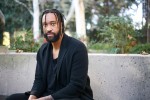Coleman Collins transitioned from shooting baskets to shooting film.
Prior to coming to UCLA, the graduate art student pursued a professional basketball career spanning over a decade, taking him to countries including Germany, Ukraine and Bahrain. However, Collins, who speaks several languages, said his time living in foreign countries inspired him to portray global issues in art, leaving his basketball career behind.
“The most formative thing was living in countries that had histories of violence or oppression,” Collins said. “Living in (countries) after wars, after genocide, after migrant issues – it allowed me to have a more global, longer perspective.”
Collins, who studied film theory as an undergraduate at Virginia Tech, began considering studying art formally five years ago, near the end of his basketball career. Though he said he enjoyed taking amateur photographs in the various countries his basketball career brought him to, he doesn’t consider his early photographs to be artistic work.
“It was all theoretical. I was experimenting with the camera, which is helpful, but I didn’t have access to art,” he said. “I didn’t grow up going to museums; I didn’t know any artists.”
Per Günther, a former teammate of Collins’ from when he played for Ratiopharm Ulm in southern Germany from 2009 to 2011, said Collins’ passion for art was evident in how he spent his free time while playing abroad.
“He was drawn to Paris; he was drawn to Berlin. He was always looking for new influences and things he could see and read about,” Günther said. “He didn’t go to major sites or shoot buildings. At first glance, you might think there was nothing in the photo, but it takes you another take to realize what he was seeing.”
While in New York 10 years ago, Collins went on a visit to the Solomon R. Guggenheim Museum at the suggestion of a friend and said it was the first time he was exposed to art as a career path.
Though Collins said he had not heard of the Guggenheim before his visit, it became a ritual for him to visit art museums on Sundays. He began to teach himself about art – reading art history textbooks, visiting galleries and asking questions of artists.
Though his professional basketball career is behind him, Collins said skills he developed during that time are beneficial in the art field. He found collaboration most important and said that his willingness to collaborate with other artists is a unique asset he cultivated when playing with teammates who did not speak his language.
“I ended up learning (their languages),” he said. “Especially when you’re in a village somewhere and no one can communicate with you, and you have to learn to communicate on their terms. I think that was really helpful for me and that’s something that I still try to draw on.”
Last summer, Collins received a travel grant from UCLA to create a piece of art relating to the migrant crisis in France. Collins said he is reviewing footage from that trip, as well as one to Nigeria, for a film project. The piece is about migration, the slave trade and history, he said. Collins said it features a massive, abandoned refugee camp in Calais, France.
“Essentially, the point is there’s a refugee crisis in Europe. There are people who come from certain countries in the Middle East and Africa who don’t have freedom of movement,” Collins said. “I’m interested in how my freedom of movement contrasts with other people’s and their lack thereof.”
Collins also wrote as a columnist for ESPN, where his editor Jim Hooper said he has never heard of a story like Collins’ in the basketball world. Impressed by Collins’ writing, Hooper asked Collins to write for his basketball blog, TrueHoop. Collins became a semi-regular contributor, writing articles including a piece on his perception of racism abroad and his experience as a basketball player at Virginia Tech during the shooting in 2007. Hooper added Collins’ creative mind allows him to stand out among other athletes.
“Being a professional athlete, there’s a lot of tediousness,” Hooper said. “With a creative mind, you might not want to spend 90 minutes working on a layup. Now he gets to have his fun career.”
Günther said Collins was driven to pursue more intellectual activities during his basketball career.
“He was actively looking for stimulus for his brain as well, not just the physical aspect,” Günther said. “He just had a ton of interests, and basketball was one of them, but it wasn’t as dominant as in other athletes I’ve met over the years.”
Collins said that UCLA’s art program has taught him to critique art very well, which can be a hindrance to actually creating art. Since coming to UCLA, he said he has learned to be more experimental with different mediums and to integrate the global perspective basketball gave him into his work. Additionally, he is excited to try mediums outside film, such as sculpture, to convey this perspective.
“I made things in defense of an imagined criticism; I wanted to make sure I wasn’t vulnerable to being imperfect,” he said. “Now, I’ve gotten comfortable with being a little messier and a little more experimental, and I think that’s really helpful. I’ve been trying to experiment with different materials. (Studying here) is a great opportunity to do things you haven’t done before.”

Well written article. Coleman Collins seems to have a brilliant mind. We’re looking forward to experiencing the art he creates.